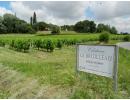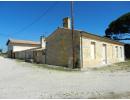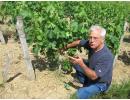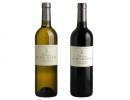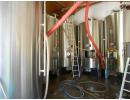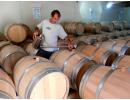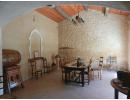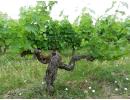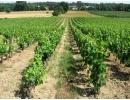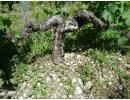Chateau Le Bruilleau
Château Le Bruilleau 2011 - Pessac-Léognan
A dry white with a blend of 75% Semillon and 25% Sauvignon Blanc. The vines are of an average age of 40 years old planted on clayey-limestone soil producing an average yield of 40 hl/ha. Before the vinification the grapes are destemmed and the skins will undergo a pre-fermentation skin maceration for 10 hours at a low temperature to extract more colour, flavours and texture. The fermentations will last 4 weeks for the Semillon at cellar temperature in french oak barrels (33% new), while the Sauvignon Blanc is fermented in stainless steel vats at 20°C to keep its freshness. The wine is then aged on fine lees for 10 months with 33% of new oak.
PVins notes: Yellow in colour, expressive nose of citrus fruits and white flowers, hints of vanilla and oak when young. Medium-bodied, nicely textured, good integration of the oak amongst the flavours and well-balanced by the Sauvignon's freshness on the finish. The wine may be cellared for up to 8 years depending on the vintage.
Château Le Bruilleau 2014 - Pessac-Léognan
The wine is a blend of 52% Merlot and 48% Cabernet Sauvignon averaging 25 to 30 years of age. Once the grapes have been hand-picked and sorted at the cellar they are destemmed. The grains will undergo a pre-fermentation skin maceration at a cold temperature for 4 to 5 days to extract extra colour, flavours and structure. The fermentations in stainless steel vats will last 3 weeks for the Merlot and 4 weeks for the Cabernet Sauvignon at 28°C. The Merlot and Cabernet are aged separately in french oak barrels for 12 months of which 25% are new, the two grape varieties will be blended at the end of the ageing period.
PVins notes: Dark red in colour, complex aromas of cedar with subtle hints of oak and ripe dark fruits. Well structured and balanced with fine grained tannins, round and fleshy on the palate, good persistence on the finish with the oak well integrated. The wine may be cellared for 10+ years depending on the vintage.
Press: Bettane & Desseauve 14.5
Aromas of red fruits, nice oak, very fleshy with its tannic structure, long and balanced palate on the finish thanks to the freshness. A tense wine, full of elegance and character.
Château Le Bruilleau is located south of Martillac in the southern part of the appellation Pessac-Léognan in the commune of St-Médard d’Eyrans. Nadine and Serge Bédicheau represent the 4th generation, their son is also involved in the runing of the estate.
The Château's vineyards made up of 5 parcels represent 10.50 ha, with 7.50 ha planted in Merlot (52%) and Cabernet sauvignon (48%) and 3 ha planted in Semillon (75%) and Sauvignon Blanc (25%). The red grapes average 25 to 30 years of age while the white grapes average 70 years old for the Semillon and 25 years old for the Sauvignon Blanc.
The parcels are situated on gentle slopes and the soils are either clayey-limestone in structure or gravelly. The Cabernet Sauvignon is planted on the gravelly parcels while the Semillon, Sauvignon Blanc and Merlot are planted on dominant clayey-limestone soil.
The Semillon, Sauvignon Blanc and Merlot are hand-picked while the Cabernet Sauvignon is machine picked. Canopy management is usually completed by the end of June and a green harvest is done when necessary. Grass is grown between the rows for the vineyard's health and bio-diversity.
The 25 to 30 years old Cabernet Sauvignon (48%) and Merlot (52%) are harvested at full maturity, producing an average yield of 48 hl/ha. On arrival at the cellar the grapes will be sorted and destemmed. Before the fermentations, a skin maceration at a cold temperature will be carried out for 4 to 5 days to extract extra colour, flavours and improve the overall structure of the wine. Then the fermentations in stainless steel vats will last 3 weeks for the Merlot and 4 weeks for the Cabernet Sauvignon at 28°C. The two grape varieties are then aged separately in french oak barrels for 12 months with 25% of new oak each year. After ageing, the Cabernet Sauvignon and Merlot will be blended together. The production is about 3,300 cases.
The white wine is a blend of Semillon (75%) and Sauvignon Blanc (25%). The Semillon vines are on average 70 years old, while the Sauvignon Blanc vines are on average 25 years old. The grapes are hand-picked at full maturity producing an average yield of 40 hl/ha. Following the sorting at the cellar, the grape varieties will be slowly pressed separately and a pre-fermentation skin maceration for 10 hours will be carried out before the fermentations, this will bring extra colour, flavours and texture. The fermentations will last 4 weeks at cellar temperature in oak barrels (33% new) for the Semilllon, while the Sauvignon Blanc will be fermented in stainless steel vats to keep its freshness and aromas. The ageing will last 10 months in french oak barrels (33% new) and the fine lees will be occasionally stirred. The Semillon and Sauvignon Blanc will be blended at the end of the ageing period. The Semillon gives the wine roundness and texture while the Sauvignon Blanc brings the freshness in the balance. The production is about 830 cases.
Links: AOP Pessac-Léognan - Pessac-Léognan map - Bordeaux map
PESSAC-LEOGNAN
The Pessac-Léognan appellation is located within the Graves sub-region of Bordeaux. It was created in 1987 based on the name of the communes Pessac and Léognan. The boundaries of Pessac-Léognan stretch to the west and south of Bordeaux representing 1,600 hectares in 10 communes. The most famous château of the appellation and the only one to have been classified in 1855, as a 1st Growth, is Château Haut Brion. But the area also comprises 16 Châteaux that were classified in 1953 and 1959 as “ Grands Crus Classés de Graves”, some are classified as red wines or dry whites or both. These Châteaux are centered around Pessac, Léognan and Talence. Also, the well-known Château Pape Clément Grand Cru Classé is the oldest named property in Bordeaux that was founded by Pope Clement V in 1306.
Vineyard
The terroir has its own complexity as the name Graves refers to its richness in pebbles and gravels of difference sizes deposited over time during the Quaternary period by the Garonne River resulting in a soil mixture that includes sand, limestone and some clay. The variable thickness of the "graves" varies from 20 cm to 3 metres in depth. The advantages of this type of terroiris that the rocks are known for releasing some heat at night after a sunny day that helps to obtain an excellent ripening of the grapes, also this poor soil provides an ideal natural drainage of the vineyard.
Pessac-Léognan is located on the left bank of the Garonne river. Both red and dry white wines are produced with the red grapes making up 2/3 of the surface planted. The minimum plantation density is 6,500 vines per hectare but more often closer it is close to 9,000 vines. The appellations authorised yields are 45 hectolitres per hectare for the reds and 48 hectolitres per hectare for the whites. The red grape varieties planted are Cabernet Sauvignon, Merlot, Cabernet Franc, Petit verdot, Malbec and Carmenère, but Cabernet Sauvignon and Merlot are the predominant grapes in the blend. The white grape varieties are Sauvignon Blanc, Sémillon, Muscadelle and Sauvignon Gris but the latter 2 are planted in very small quantity.
Cabernet Sauvignon grows wonderfully in the gravelly soils, expressing its powerful and complex personality, it gives the wine its structure with firm tannins providing an excellent aptitude for ageing. The Merlot brings extra flavours in the blend and softens the tannins of the Cabernet Sauvignon, thus bringing a degree of suppleness. When young, the wines are deep and intense in colour. The nose is full of finesse with aromas of crushed berries, ripe fruits as well as hints of vanilla, grilled almonds and toast from the oak. As they mature, the bouquet becomes more complex with spicy aromas and the firmness of the tannins softens to become velvety after a long cellaring.
The dry white wines of Pessac-Léognan are produced mainly from Sauvignon Blanc which is often the dominating grape and Sémillion. The Sauvignon Blanc brings structure, freshness and fruitiness. The Sémillion is easy to maintain and ripen in the poor Graves soils with its sandy and limestone structure. The variety offers a unique body to the wine and brings aromas of candied fruit. In appearance when young the wines show a paleness of straw-yellow colour, evolving to a deep golden yellow colour after ageing 10, 15 and sometimes 20 years. The nose shows lime-flower with broom tree aromas and hints of honey, candied fruits and vanilla. On the palate the white Pessac-Léognan is powerful and yet subtle, complex, fleshy and round, expressing pleasant hints of bay leaf or hints of blackcurrant on a great aromatic long finish.
Climate
Located on the 45th parallel, Pessac-Léognan benefits from a temperate climate. The region is relatively warm and humid with regular sunshine influenced by the nearby Atlantic Ocean, whilst also benefitting from the protection of the important pine forest "forêt des landes" to the west, as the relatively strong winds blowing in from the Atlantic Ocean are slowed down. The ocean and river both play an important part in regulating the temperature of the area. Generally speaking, the rain comes between autumn and spring and statistically, it can be said that summers in the Bordeaux area are relatively hot and dry especially when exceptional vintages are produced.



